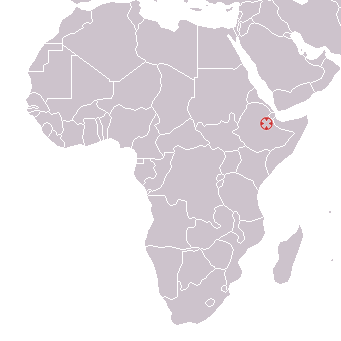Homo sapiens idaltu
Homo sapiens idaltu (Afar: Idaltu; "elder" or "first born"[1]), also called Herto Man,[1] is the name given to a number of early modern human fossils found in 1997 in Herto Bouri, Ethiopia. They date to around 160,000 years ago.[2]
| Homo sapiens idaltu | |
|---|---|
| Homo sapiens idaltu skull | |
| Scientific classification | |
| Kingdom: | Animalia |
| Phylum: | Chordata |
| Class: | Mammalia |
| Order: | Primates |
| Suborder: | Haplorhini |
| Infraorder: | Simiiformes |
| Family: | Hominidae |
| Subfamily: | Homininae |
| Tribe: | Hominini |
| Genus: | Homo |
| Species: | |
| Subspecies: | H. s. idaltu |
| Trinomial name | |
| Homo sapiens idaltu Unknownet al., 2003 | |
Palaeoanthropologists determined that the skeletal finds belong to an extinct group of Homo sapiens who lived in Pleistocene Africa. The subspecies H. s. idaltu falls under the umbrella of Anatomically modern humans.[1][2][3] The recognition of H. s. idaltu as a valid subspecies of the anatomically modern human lineage would justify the description of contemporary humans with the subspecies name H. s. sapiens,[1] though physical anthropologist Chris Stringer does not consider idaltu distinct enough within H. sapiens to warrant its own subspecies designation, and instead classifies it simply as anatomically modern H. sapiens.[4][5][3] Palaeoanthropologist Tim D. White and others consider the fossils represent the probable immediate ancestors of anatomically modern humans.[1][6]
Discovery

The fossilized remains of Homo sapiens idaltu were discovered at Herto Bouri near the Middle Awash site of Ethiopia's Afar Triangle in 1997 by Tim White, Giday WoldeGabriel and Berhane Asfaw, but were first unveiled in 2003.[1] Herto Bouri is a region of Ethiopia under volcanic layers. According to radioisotope dating, the layers are between 154,000 and 160,000 years old. Three well preserved crania are accounted for, the best preserved being from an adult male (BOU-VP-16/1) having a brain capacity of 1,450 cm3 (88 cu in). The other crania include another partial adult male and a six-year-old child.[1]
Morphology and taxonomy
The Herto remains differ from those of chronologically later forms of early Homo sapiens; their morphology has features that show resemblances to African fossils, such as huge and robust skulls, yet have a globular shape of the brain-case and the facial features typical of H. sapiens.[1][7]
These specimens are regarded by some as an extinct Homo sapiens subspecies that may have been direct ancestors of modern Homo sapiens sapiens which, according to the "recent African origin (RAO)" or "out of Africa" model, developed shortly after this period (Khoisan mitochondrial divergence dated not later than 130,000 BCE) in Eastern Africa.[8][9] "The many morphological features shared by the Herto crania and AMHS, to the exclusion of penecontemporaneous Neanderthals, provide additional fossil data excluding Neanderthals from a significant contribution to the ancestry of modern humans."[1]
Dating
A 2005 potassium-argon dating of volcanic tuff associated with the Omo remains showed them to date from around 195,000 years ago. This makes the fossils the earliest known remains of anatomically modern humans, older than the idaltu specimens.[10]
Contrary opinion
Anthropologist Chris Stringer argued in a 2003 article in the journal Nature that "the skulls might not be distinctive enough to warrant a new subspecies name".[4][5]
See also
- Omo remains
- Archaic humans
- Timeline of human evolution
- Life timeline
- List of fossil sites
- List of human evolution fossils
- Nature timeline
References
- White, Tim D.; Asfaw, B.; DeGusta, D.; Gilbert, H.; Richards, G. D.; Suwa, G.; Howell, F. C. (2003), "Pleistocene Homo sapiens from Middle Awash, Ethiopia", Nature, 423 (6491): 742–747, Bibcode:2003Natur.423..742W, doi:10.1038/nature01669, PMID 12802332
- Sanders, Robert (June 11, 2003). "160,000-year-old fossilized skulls uncovered in Ethiopia are oldest anatomically modern humans". UC Berkeley. Retrieved May 2, 2020.
- Stringer, C. (2016). "The origin and evolution of Homo sapiens". Philosophical Transactions of the Royal Society of London. Series B, Biological Sciences. 371 (1698): 20150237. doi:10.1098/rstb.2015.0237. PMC 4920294. PMID 27298468.
- Stringer, Chris (June 12, 2003). "Human evolution: Out of Ethiopia". Nature. 423 (6941): 693–695. Bibcode:2003Natur.423..692S. doi:10.1038/423692a. PMID 12802315.
- "Herto skulls (Homo sapiens idaltu)". talkorigins org. Retrieved June 7, 2016.
- Smith, Fred H.; Ahern, James C. (2013-07-09). The Origins of Modern Humans: Biology Reconsidered. John Wiley & Sons. ISBN 978-1-118-65990-8.
- "HOMO SAPIENS IDALTU". Bradshaw foundation. Retrieved June 7, 2016.
- http://www.bradshawfoundation.com/origins/homo_sapiens_idaltu.php
- http://projects.leadr.msu.edu/hominidfossils/exhibits/show/modern-homo/homo-sapiens--idaltu
- McDougall, I.; Brown, F. H.; Fleagle, J. G. (2005), "Stratigraphic placement and age of modern humans from Kibish, Ethiopia", Nature, 433 (7027): 733–736, Bibcode:2005Natur.433..733M, doi:10.1038/nature03258, PMID 15716951
External links
| Wikimedia Commons has media related to Homo sapiens idaltu. |
| Wikispecies has information related to Homo sapiens idaltu |
- Missing link in human evolution found in Africa (abc.net.au 12 June 2003)
- BBC report and image of the reconstructed skull discovered at Herto
- Homo sapiens idaltu - Nature Journal Article
- Fossil Hominids - Middle Awash Research Project
- Origins - Discovery of Earliest Homo Sapien Skulls backs 'Out of Africa' Theory - Homo sapiens idaltu Bradshaw Foundation